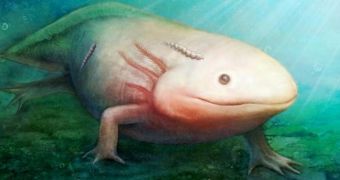A recent paper in the journal eLIFE describes a grisly parasite that roamed the Earth about 165 million years ago, in the Jurassic, and that researchers say had a sweet tooth for salamander blood.
The parasite, visible on the back of the salamander in the image above, was not all that impressive size-wise. On the contrary, researchers say that it was merely a fly larva about 2 centimeters (0.78 inches) long.
However, its anatomical makeup made it well worthy of starring in a horror movie. Thus, evidence indicates that its chest was shaped like a sucking plate, and allowed it to cling to the body of its victim.
Having attached itself to its next meal, the parasite penetrated its skin with its tube-shaped mouth and proceeded to drink as much blood as it could fit inside its otherwise tiny body.
As detailed in the journal eLIFE, this parasitic fly larvae is now known to the scientific community as Qiyia jurassica. Specialists say that it likely inhabited freshwater lakes of present-day Mongolia.
Interestingly enough, Prof. Jes Rust with the University of Bonn in Germany and his colleagues say that the scientific community is yet to encounter another insect as specialized to secure its next meal as this little fellow was.
“The extreme adaptations in the design of Qiyia jurassica show the extent to which organisms can specialise in the course of evolution,” the researcher explains in a statement.

 14 DAY TRIAL //
14 DAY TRIAL //